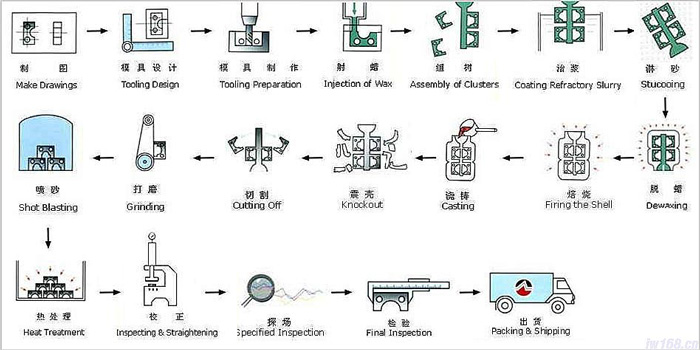The Investment Casting Process
Investment casting is also called lost wax casting or precision casting, which is a metal forming method to produce parts with tight tolerances, complex inner cavities and precise dimensions.
The main processes are as followings:

You know that investment casting was originated thousands of years ago. Over the years, with the rapid development of innovative equipment and methodology, investment casting is becoming one of the most popular forms of metal casting.
At the above, we said investment casting is also called “lost wax casting”, but actually the wax is not lost, instead, the wax was melted and collected, then purified and used in the next wax pattern workshop.
Investment casting is a manufacturing process in which a liquid material is poured into a ceramic shell, which contains a hollow cavity of the desired shape, and then allowed to solidify. The solidified part is the casting, which is broken away from the ceramic shell to complete the process.
1. Wax Pattern - The process begins with a precision-engineered wax replica of the desired end product—the key to achieving such a detailed casting. The wax replica is produced from a wax injection mold that is built and can reproduce millions of wax parts over its lifetime.
2. Shell Making – The wax “pattern” is then dipped into a ceramic slurry several times, drying between each dip, building a strong ceramic shell around the wax pattern(s). Within a high pressure and heat vessel, the wax is then melted out and creates the ceramic mold hence the name “lost wax” casting. The ceramic shell is then placed into a high temperature oven to roasting and prepare for accepting molten metal.
3. Pouring - The shell is preheated in a furnace to approximately 1000°C and the molten metal is poured from a ladle into the gating system of the roasted shell, filling the shell cavity. Pouring is typically achieved manually under the force of gravity, but other methods such as vacuum or pressure are sometimes used.
4. Cooling - After the shell has been filled, the molten metal cools and solidifies into the shape of the final casting. Cooling time depends on the thickness of the part, thickness of the mold, and the alloy used.
5. Shell Removal - After the metal has cooled to the touch, the ceramic shell can be broken away from the part(s), and the casting removed. The ceramic mold is typically broken using water jets, vibration, or other methods. Once removed, the parts are separated from the gating system by either cutting off or cold breaking.
6. Finishing - Often, post-cast finishing operations such as grinding, sandblasting, or shot-blasting are used to remove the gate(s). Heat treatment is also sometimes used to anneal or harden the final part before sending to the customer.
So if need any engineering suggestions about your projects, or inquiry us on your precision metal components, please feel free to contact us.





